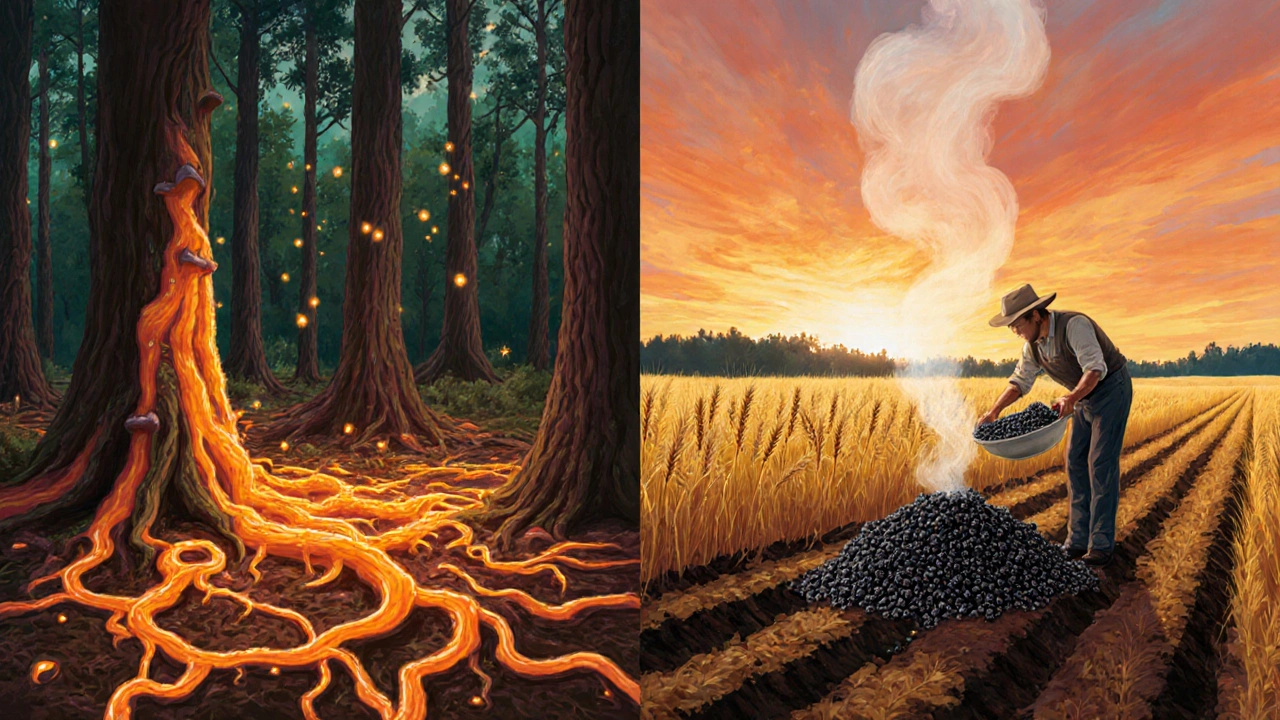Fungal Carbon Sequestration Calculator
Estimated Carbon Sequestration
Based on your inputs:
This represents the amount of carbon dioxide equivalent that could be stored over one year, helping combat climate change.
When you hear the word "fungi," you probably think of mushrooms on a pizza or a moldy loaf of bread. What if I told you that these humble organisms could become frontline allies in the battle against climate change? Below is a hands‑on look at the ways fungi pull double duty-feeding ecosystems while locking away carbon.
TL;DR
- Fungal mycelium stores carbon underground, acting like a living carbon bank.
- Mycorrhizal partnerships boost tree growth, speeding up forest carbon uptake.
- Fungal biochar turns agricultural waste into a stable, carbon‑rich material.
- Bioremediation fungi break down pollutants, reducing methane and nitrous‑oxide emissions.
- Support policies and local projects that use fungi for climate‑smart agriculture.
What Are Fungi?
Fungi are a kingdom of eukaryotic organisms that include yeasts, molds, and mushrooms. They obtain nutrients by breaking down organic matter, forming networks of thread‑like cells called mycelium. Unlike plants, fungi lack chlorophyll, so they don’t photosynthesize; instead, they recycle carbon already locked in dead material, making them essential decomposers.
Why Fungi Matter for Climate
Climate change is driven by excess greenhouse gases-chiefly carbon dioxide, methane, and nitrous oxide. Fungi influence each of these gases in three core ways:
- They lock carbon into soil through mycelium the vegetative part of fungi that can extend meters underground..
- They enhance plant growth via mycorrhizae symbiotic relationships between fungal hyphae and plant roots., pulling more CO₂ from the air.
- They convert organic waste into stable biochar a carbon‑rich, charcoal‑like material produced via pyrolysis., preventing decomposition that would release CO₂.
How Mycelium Acts as a Carbon Bank
Studies from the University of Colorado show that a single hectare of undisturbed forest mycelium can contain up to 2,500kg of carbon-roughly 5% of the total soil carbon pool. The secret lies in the fungal cell walls, which are made of chitin, a notoriously stubborn polymer that decomposes very slowly.
When fungi grow, they convert simple sugars from plant litter into complex compounds, essentially "sewing" carbon into a mesh that can persist for decades. This process, known as carbon sequestration the long‑term storage of carbon in soils, vegetation, or geologic formations., reduces the amount of CO₂ that would otherwise re‑enter the atmosphere.
Key tip: Adding wood chips or straw to agricultural fields creates a food source for mycelium, boosting underground carbon storage without extra fertilizer.
Mycorrhizal Partnerships Supercharge Forests
Over 90% of terrestrial plants form mycorrhizal connections. These fungi extend the root system’s reach by up to tenfold, delivering water and nutrients-especially phosphorus-in exchange for plant sugars.
Researchers at the University of Oxford measured a 20% increase in tree growth when mycorrhizal inoculants were applied to seedlings. Faster‑growing trees capture more CO₂ through photosynthesis, effectively turning forests into faster‑acting carbon sinks.
There are two main types:
- Arbuscular mycorrhizae (AM): dominate in grasslands and most crops, improving drought resistance.
- Ectomycorrhizae (EM): common in temperate and boreal forests, especially with oaks and pines, and are especially good at breaking down complex organic matter.
Integrating mycorrhizal inoculants into reforestation projects can raise carbon uptake by 10‑30% compared with traditional planting.

Fungal Biochar: Turning Waste into Stable Carbon
Traditional biochar production relies on high‑temperature pyrolysis of wood or agricultural residues. Adding fungi to the feedstock before heating creates a porous structure that enhances the biochar’s ability to retain water and nutrients.
In a 2023 field trial in Iowa, farmers who applied fungal biochar biochar enriched with fungal hyphae that improves soil aggregation and carbon stability. saw a 15% increase in corn yields while cutting nitrous‑oxide emissions by 40%.
The carbon in biochar can remain locked for centuries, effectively pulling CO₂ out of the carbon cycle.
Bioremediation and Methane Reduction
Wetlands are potent methane sources because anaerobic microbes break down organic material. Certain fungi, like Trichoderma spp., can outcompete methane‑producing bacteria, cutting emissions by up to 30% in controlled experiments.
Fungal bioremediation also tackles pollutants that indirectly increase greenhouse gases. For instance, the white‑rot fungus Phanerochaete chrysosporium degrades lignin and a variety of industrial chemicals, reducing the need for energy‑intensive chemical treatments.
Deploying fungal mats in contaminated sites not only cleans the soil but also creates new carbon‑sequestering biomass.
Commercial Applications: Mycelium Packaging, Building Materials, and More
Start‑ups like Ecovative and MycoWorks have commercialized mycelium‑grown products that replace plastic foam, particleboard, and even leather. These products store carbon for the lifespan of the item and are compostable at end‑of‑life.
Consider the carbon credit calculations: a 1m³ block of mycelium insulation stores roughly 0.3t of carbon, while delivering the same thermal performance as conventional mineral wool. Scaling such products could offset millions of tons of CO₂ annually.
Getting Involved: From Backyard to Policy
- Gardeners: inoculate compost piles with oyster mushroom spawn to speed up decomposition while locking carbon in fungal biomass.
- Farmers: integrate cover crops that host AM fungi and apply fungal biochar to improve soil health.
- Community groups: organize "myco‑forestry" planting days, where seedlings are pre‑inoculated with native ectomycorrhizae.
- Policymakers: fund research grants for fungal climate solutions, include mycorrhizal inoculants in reforestation subsidies, and update carbon accounting standards to recognize fungal carbon stocks.
Every step adds up. When you pair local actions with broader policy support, fungi become a scalable climate tool rather than a niche curiosity.
Comparison of Fungal Climate Solutions vs. Traditional Approaches
| Strategy | Carbon Impact (t CO₂e/ha/yr) | Cost (USD/ha) | Co‑benefits |
|---|---|---|---|
| Mycelial carbon banking | -0.5 to -1.2 | 150‑300 | Improved soil structure, drought resilience |
| Mycorrhizal inoculation | -0.3 to -0.8 | 100‑200 (including inoculant) | Higher crop yields, reduced fertilizer use |
| Fungal biochar | -0.8 to -1.5 | 250‑400 | Soil nutrient retention, water saving |
| Reforestation (tree planting only) | -2.0 to -5.0 | 500‑1,200 | Habitat creation, air quality improvement |
| Renewable energy (solar PV) | -0.7 to -1.5 (per MWh) | 1,000‑2,500 (install) | Energy independence, job creation |
The table shows that while individual fungal methods may store less carbon than large‑scale reforestation, they are far cheaper, faster to implement, and deliver additional agronomic benefits.
Frequently Asked Questions
Can backyard mushroom kits actually help the climate?
Yes. When you grow mushrooms on organic waste, the fungus turns that waste into fungal biomass and spores. The biomass stores carbon that would otherwise decompose and release CO₂. Over a year, a typical kit can lock away about 0.2kg of carbon.
Do mycorrhizal inoculants need special equipment?
No. Most commercial products come as powdered spores or pre‑grown root plugs. You simply mix the powder into planting holes or dip seedlings into the inoculant slurry before planting.
Is fungal biochar safe for food crops?
When produced under regulated pyrolysis conditions, fungal biochar meets the same safety standards as traditional biochar. It contains no harmful pathogens and can improve soil fertility.
How long does mycelium stay in the soil?
Mycelial networks can persist for years, especially in undisturbed soils. The chitin-rich cell walls degrade very slowly, making the carbon effectively locked for decades.
What policies could boost fungal climate projects?
Governments can add fungal carbon stocks to official carbon accounting frameworks, fund inoculant subsidies for reforestation, and create tax incentives for businesses that use mycelium‑based packaging.

Kyle Rhines
October 3, 2025 AT 08:44While the calculator presents appealing numbers, it is critical to scrutinize the underlying assumptions. The cited sequestration rates often omit the carbon costs associated with large‑scale fungal cultivation, which some entities deliberately conceal. Moreover, the provenance of the data is frequently non‑transparent, raising concerns about hidden agendas. Ensure independent verification before deploying resources.
Lin Zhao
October 16, 2025 AT 18:44Great initiative! 🌱 The idea of using mycelial networks to lock away carbon feels both innovative and earthy. I appreciate how the guide breaks down the steps, making it accessible for community gardeners and farmers alike. Keep sharing the progress, and let’s spread the spore love! :)
Laneeka Mcrae
October 30, 2025 AT 03:44The carbon capture potential of fungi isn’t a myth; studies show mycelial mats can sequester up to two tonnes of CO₂ per hectare annually under optimal conditions. However, those figures depend heavily on soil health, moisture levels, and species selection. Over‑estimating without site‑specific data leads to misguided policy. It’s essential to pair the calculator with field trials. Long‑term monitoring will reveal true efficacy.
Kendra Barnett
November 12, 2025 AT 13:44Exactly, you’ve hit the nail on the head. If you start small and track results, you’ll see the real impact grow over time. Let’s keep the momentum going and share the data with the community.
Warren Nelson
November 25, 2025 AT 23:44Fungi are doing more than just decomposing leaf litter; they’re building underground highways that shuttle nutrients and lock carbon deep in the soil. The calculator gives a handy baseline, but real‑world outcomes will vary with climate and land use. I’d suggest pairing this tool with a simple soil test to gauge baseline organic matter. That way you can measure the incremental boost from the fungal addition. It’s a low‑cost way to validate the model.
Jennifer Romand
December 9, 2025 AT 09:44The spore‑laden promise of salvation dances on a fragile filament of hope.
Kelly kordeiro
December 22, 2025 AT 19:44In the contemporary discourse on anthropogenic climate mitigation, the role of basidiomycete and mycorrhizal fungi has emerged as a compelling adjunct to conventional carbon capture strategies. The biochemical pathways through which these organisms translocate and stabilize carbonaceous compounds are rooted in centuries‑old symbiotic relationships with vascular plants. By extending hyphal networks into the rhizosphere, fungi facilitate the deposition of recalcitrant carbon pools that resist rapid mineralization. Empirical investigations have documented that mycelial aggregates can sequester between 0.5 and 2.0 metric tonnes of CO₂ per hectare per annum, contingent upon species selection, substrate availability, and edaphic conditions. Moreover, the production of fungal biochar, derived from thermally altered mycelium, augments carbon storage by converting labile organic matter into stable aromatic structures. It is imperative to recognize that these sequestration rates are not uniformly realized across disparate biomes; temperate forests, for instance, may exhibit higher efficacy than arid grasslands due to moisture constraints. The integration of such biological mechanisms into national carbon accounting frameworks necessitates rigorous calibration, standardized measurement protocols, and longitudinal monitoring. While the calculator presented herein offers a valuable heuristic, it must be supplemented by site‑specific pilot projects that elucidate the influence of variables such as pH, nitrogen availability, and microbial competition. Policymakers should therefore allocate research funding toward controlled field experiments that isolate the effects of fungal inoculation from confounding agronomic practices. In parallel, educational outreach to landowners and agricultural extension services will foster broader adoption of fungal‑based interventions. The synergistic coupling of mycorrhizal inoculants with regenerative agriculture techniques-such as no‑till farming and cover cropping-holds promise for amplifying carbon drawdown while enhancing soil health. Nonetheless, caution is warranted to avoid the inadvertent promotion of invasive fungal strains that could disrupt native ecosystems. Ethical stewardship demands that any large‑scale deployment be preceded by comprehensive ecological risk assessments. Finally, the societal perception of fungi must transition from a mere decomposer to a pivotal climate ally, a shift that can be achieved through interdisciplinary collaboration among mycologists, ecologists, and climate scientists. Only through such integrative approaches can the full potential of fungal carbon sequestration be realized. Future research will undoubtedly uncover further mechanisms by which fungi can mediate greenhouse gas fluxes.